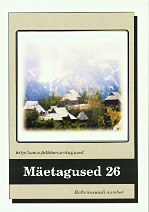17. sajandi usuline situatsioon Vene-Rootsi piirialal
The Religious Situation on the Russian-Sweden Border in the 17th Century
Author(s): Adrian SelinSubject(s): History
Published by: Eesti Kirjandusmuuseum
Summary/Abstract: The article is based on two data corpora. The first corpus is the so called "Porubezhnye (Borderline) Acts" which is a part of the 17th century Novgorod Ambassador Court Archives held in the Archives of St. Petersburg Branch of the Institute of Russian History. The second corpus is a part of Kammararkivet, named Baltiska Fogderäkenskaper, and consists of the economic acts and deeds made in Ivangorod, Iam, Koporie, Oreshek (Noteburg), Nevsky Ostrozhek (Nyen), Gdov and on the territories ascribed to the fortresses in 1580-1589 and 1612-1618. During the Novgorod-Swedish administration 1611-1617 these relations were pliable (there were even parleys about a possible contact between the two Churches), but after the Stolbovo Treaty 1617 interrelations between the churches had become deteriorating. The Swedish government tried to control the Orthodox clergy in the annexed districts, while the Moscow state attempted to leave it under the control of the archbishop of Novgorod. In the mid-17th century new factors in the everyday life in the Russian-Swedish border region revealed. A new wave of Orthodox migrants from Ingermanland and the Kexholm district in Sweden arrived at the Moscow State and at the same time patriarch Nikon's church reform was held. This circumstance has partly shaped the general attitudes towards the migrants: traditionally they were perceived as schismatics. The most important factor was the language barrier between the migrants, Izhorians and Karelians, and the autochthonous Russian population in the borderline area and the inside territories where the migrants had settled (the so called Tver' Karelia). To sum up, the transition of some Novgorod Orthodox districts to the Lutheran State had created a principally new precedent. As known, the concepts of confession and citizenship were practically identical in the 16th -17th century popular thought, when Orthodoxy automatically meant Moscow citizenship. The transition of a number of Orthodox parishioners to foreign citizenship had significantly troubled both the Moscow Governors and the clergy, and had created an atmosphere of uncertainty, where nobody knew who factually had the right to appoint priests, etc. The possible way out was to appoint a local bishop for the Orthodox parishes in Ingermanland but that, of course, was impossible for the Moscow governors. The result was a paradoxical situation where the church ruling, justice, and administration of the Orthodox parishes were handed over to probsts - special officials appointed by the Swedish Lutheran government.
Journal: Mäetagused. Hüperajakiri
- Issue Year: 2004
- Issue No: 26
- Page Range: 39-52
- Page Count: 14
- Language: Estonian

